Contemporary Church History Quarterly
Volume 27, Number 3 (September 2021)
Review of Wilfried Loth, “Freiheit und Würde des Volkes:” Katholizismus und Demokratie in Deutschland, Religion und Moderne, Vol. 13 (Frankfurt am Main: Campus Verlag, 2018). ISBN 978-3-593-50838-2.
By Martin R. Menke, Rivier University
Wilfried Loth is a well-known German historian. In addition to research on nineteenth-century German Catholicism, he has also published on the early Cold War, on the history of France, and on European unification. In this collection of fourteen previously published essays, Loth analyzes Catholics’ contributions to the development of democracy in Germany since the mid-nineteenth century. Loth offers a nuanced analysis based on an impressive command of the scholarly literature and archival sources. He argues that while the institutional Church opposed modernity until after World War II, lay Catholics, especially those organized in political parties, contributed significantly to the development of modern democracy in Germany.
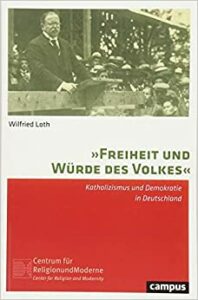 Loth argues that much relevant scholarship has rested on Rainer Lepsius’ theory of a closed Catholic milieu, largely dominated by ultramontane clergy.[1] According to Loth, instead of a stereotype of German Catholicism dominated by clergy and uniform in thought and practice, German Catholics learned early that defending modern goals such as the constitutional order, a responsible ministry, and the defense of civil rights was the best way to defend Catholic faith and values against in a secularized world. Loth’s analysis represents a strain of scholarship dating back to Margaret Lavinia Anderson’s Practicing Democracy: Elections and Culture in Imperial Germany and including Margaret Stieg Dalton’s Catholicism, Popular Culture and the Arts in Germany, 1880-1933, as well as Mark Edward Ruff’s The Wayward Flock: Catholic Youth in Postwar West Germany, 1945-1965, and others. [2]
Loth argues that much relevant scholarship has rested on Rainer Lepsius’ theory of a closed Catholic milieu, largely dominated by ultramontane clergy.[1] According to Loth, instead of a stereotype of German Catholicism dominated by clergy and uniform in thought and practice, German Catholics learned early that defending modern goals such as the constitutional order, a responsible ministry, and the defense of civil rights was the best way to defend Catholic faith and values against in a secularized world. Loth’s analysis represents a strain of scholarship dating back to Margaret Lavinia Anderson’s Practicing Democracy: Elections and Culture in Imperial Germany and including Margaret Stieg Dalton’s Catholicism, Popular Culture and the Arts in Germany, 1880-1933, as well as Mark Edward Ruff’s The Wayward Flock: Catholic Youth in Postwar West Germany, 1945-1965, and others. [2]
One might question why a collection of Loth’s articles, which are generally well known, is needed. In the introduction, Loth warns that, “a quarter century after the collapse of the Soviet bloc, western pluralism, parliamentary democracy, and European unification suddenly no longer belong to the secure elements of the social order in Germany and Europe.”(9) Loth blames this decline on the alienation of social elites, middle strata and lower classes. He claims that reviewing the contribution of German Catholics to the country’s democratization might be useful to the development of a vigilant and self-asserting democracy, which the national Catholic convention of 2018 demanded. Keeping this admonition in mind lends the essay additional coherence.
In the first essay, Loth reviews the ultramontane attitude of the nineteenth-century Catholic hierarchy. Rather than considering Leo XIII, author of rerum novarum, as a modernizer, Loth reminds the reader that the church rejected all Catholic organizations beyond the control of the hierarchy, which impeded the social integration of Catholics. By the early twentieth century, however, German Catholics desired full integration into the majority society. To this end, the Center Party, the Volksverein, and the Görresgesellschaft were founded to further the Catholic laity’s political interests free of the hierarchy, to educate the lower classes, and to create a forum for Catholic scholars and intellectuals. Loth argues in his second essay that Bismarck’s Kulturkampf did more for Catholic unity than the ultramontane faction could ever have done.
In the third chapter, Loth convinces the reader that assumptions about a coherent and homogeneous Catholic milieu are erroneous. This is both Loth’s most important and most controversial contribution to scholarship, first made in his Habilitationsschrift of 1984. He describes a Catholic bourgeoisie bent on emancipation in the Reich, populist tendencies among peasants and freeholders, as well as among the petit bourgeoisie, and finally, a Catholic labor movement. In this essay in particular, Loth offers such a nuanced and differentiating analysis to prove generalizations about “the” Catholic milieu become impossible. Rather, it is resistance against discrimination that brings Catholics together in support of the Center Party as the broadest Catholic organization.
In the fourth essay, Loth addresses the milieu thesis more directly, again with notable differentiation. He distinguishes between frequenting the sacraments and the liturgies on the one hand and living a life of Catholic daily practices and habits. What milieu may have formed would arise regionally to defend against discrimination. After 1945, the milieu disappeared completely. Loth concludes, “Political Catholicism and Catholic milieu constituted transitional phenomena. If these were created to resist modernity, Catholics instead ended up helping shape modernity.”(107)
In the following essay on the priest Georg Friedrich Dasbach, as in the essays on the resister Nikolaus Groß and on the Center Party’s colonial politics, Loth inserts case studies to illustrate his broader arguments. Father Dasbach established a publishing enterprise in which he supported small freeholders. His calls for reform led to a Prussian state repression against him. Dasbach’s engagement for small freeholders, vintners, and the miners of the Saar brought him the disapproval of Catholic notables. Against the wishes of the Center Party leadership, the voters returned him to the Reichstag with 92 percent of the vote. This man’s fight against both state repression and the Catholic elites demonstrates the impossibility of a homogeneous Catholic milieu.
In the sixth essay, Loth describes the work of late nineteenth-century Catholic social thinkers such as Georg Hertling, Father August Pieper of the Volksverein, and the future Reich labor minister, Father Heinrich Braun, who openly rejected ultramontane attitudes and demanded Catholic teaching be rendered effective in laws to protect workers and their families. Loth further discussed the Volksverein in a separate chapter. He explains its transitional character to facilitate the entry of Catholic workers into the broader trade union movement. It began as an organization to protect Catholic workers from socialist temptations, then briefly became the voice of Catholic labor as a whole. After World War One, however, Catholic workers no longer needed the Volksverein as interdenominational Catholic unions now provided an attractive venue for the political and social formation of workers. Analyzing Catholic unions more specifically in a separate essay, Loth explains the eventual victory of Catholic workers over the ultramontane pressures of the hierarchy. Despite near-condemnation from Rome, the Christian unions prevailed and thrived until 1933.
The ninth essay is probably the least satisfactory, largely because it addresses too great a time span. Loth addressed the development of political Catholicism from the Wilhelmine empire to the end of Weimar. Of the thirty pages of the essay, only five are devoted to the Weimar period before 1930. Loth concisely summarizes the Center Party’s struggles against the ultramontane hierarchy, against increasingly marginalized Catholic notables and nobles, and against the distrust of the Reich’s leadership. Loth convincingly argues that the Center drove towards the establishment of responsible government in a parliamentary democracy even before 1914. He cites the Center’s role in colonial politics, in the military budget. While in 1912, Matthias Erzberger, one of the Center’s young hotheads, openly demanded parliamentary democracy, the Center’s leaders avoided risking an open break with the government. Soon, however, the party’s labor wing demanded more radical measures to protect its interests, which amounted to reforms limiting the power of the dynasty, the nobility, and other elites. In this chapter, Loth argued the Center Party downplayed its demands for parliamentary government in 1918 due to the rapidly evolving constitutional crisis. One might argue, however, that by late summer, the Center’s role in the mixed committee of political parties (the Interfraktionelle Ausschuß) in the Reichstag amounted to the that of a party with governing responsibility, especially in uncovering the navy’s falsification of data claiming great achievements in submarine warfare and then, after August 1918, exercising de facto legislative and increasingly executive power. Also, describing the 1920’s, Loth exaggerates the degree to which the Center Party leadership adopted utopian notions of organic corporatism and revived medieval Reich. In fact, the Center focused primarily on quotidian demands and needs until 1933, perhaps too much so. Loth further argues that Heinrich Brüning, the last Center Party chancellor, actively sought to exclude the SPD from government, which is questionable. Loth agrees with Larry Eugene Jones and others that German parliamentary democracy ended in 1930, not later.
The essay on colonial politics is oddly placed between the essay on the role of the Catholic Center Party before 1930 and the chapter on 1933. Loth claims that Catholic support for colonial expansion reflected the end of Catholic rejection of capitalism. Furthermore, Loth argues that Catholics supported colonialism to demonstrate loyalty to the Reich’s leadership and as a means to exploit its crucial role in the Reichstag. Colonial politics, however, alienated small freeholders and workers from the Center. The burden of naval armaments and the fear of social decline led many Catholics to reject Germany’s drive for global influence.
In a crucial chapter on the rise of National Socialism, Loth adopts the arguments generally accepted today. Neither the Church nor the party chairman, Monsignor Ludwig Kaas, sacrificed the party for the concordat. Loth does argue, however, that while Kaas and the hierarchy did not stab the party in the back, they did not explore possible alternatives to supporting the Enabling Act or negotiating the Concordat.
In an essay on the Catholic resistance to the National Socialist regime, Loth largely summarizes well-known scholarship about the internal divisions in the German hierarchy. He criticizes the Church for not doing more to mobilize German Catholics against the regime. Here again, Loth adds an essay illustrating his point. This time, he focuses on the Christian union official Nikolaus Groß. Groß opposed the regime and eventually collaborated with members of the Abwehr in the planning of the July 20, 1944 attempt on Hitler’s life, for which Groß paid with his life.
In a last essay, published in 2012, Loth summarizes the argument made in this volume. He emphasizes the ambiguity between the anti-modern ultramontane positions of much of nineteenth century Catholic leaders on the one hand and the development of lay Catholic movements and initiatives on the other. The latter, Loth argues, stemmed from the laity, not the hierarchy, with the intention both of securing Catholic rights in a modern secular world but increasingly also to shape the values and policies of that world. German Catholicism became an advocate for workers, for Poles, Alsatians, for peasants and small freeholders. The Kulturkampf resulted in German Catholics’ advocacy of the civic rights and equality for all Germans, which led the Center Party to the defense of parliamentary democracy in the Wilhelmine period and to participation in many Reich cabinets of the Weimar Republic. Resistance to National Socialism led Catholics to prize cooperation of all democratic forces, regardless of religious identity. After 1945 all over Europe, Catholics actively participated in Christian Democratic parties, which in turn contributed much to the development of post-war democracy. Loth concludes, “In the long run, the ideas of solidarity and subsidiarity in contemporary debates about the future of the social welfare state in continental Europe can be considered a legacy of Catholic experience.” Loth hopes this experience and these principles will contribute to remedies for the weakening of state instruments across Europe.
While in a collection of essays representing the span of Loth’s career one cannot expect new archival discoveries or interventions in contemporary scholarly debates, this volume nonetheless serves useful ends. Loth reminds the reader of the milieu-debate, still smoldering among scholars of German Catholicism. By his argument against a homogeneous, national, and persistent milieu, Loth gives one the impression that those who insist on the existence of a milieu might be those who wish to simplify German Catholicism in order to offer over-generalized critiques.[3] Loth himself, however, limits his argument against the existence of a milieu by referring to regional milieux created against outside pressures. Kicking off this debate, by his own admission unintentionally might be Loth’s greatest scholarly legacy. Loth also argued that the Center’s contribution specifically and German Catholicism generally to the parliamentarization and thus to the democratization of Germany is one of its most unrecognized merits. In this volume, now published three years, ago, Loth reminds Germans how dear the price paid for the establishment of parliamentary democracy and the firm commitment to civil rights has been. To support his warning about the endangerment of parliamentary democracy in the early twenty-first century, Loth’s work analyzes the historical example of the alienation between Catholic nobles, notables, and middle class from Catholic workers and small freeholders, which eventually contributed to the collapse of Germany’s first attempt at parliamentary democracy. It might be beneficial for colleagues teaching German history and the history of Christianity in history to integrate his analysis into their lectures.
Notes:
[1] M. Rainer Lepsius, “Parteiensystem und Sozialstruktur. Zum Problem der Demokratisierung der deutschen Gesellschaft” in Wilhelm Abel et al., eds. Wirtschaft, Gesellschaft und Wirtschaftsgeschichte: Festschrift zum 65. Geburtstag von Friedrich Lütge (Stuttgart: G. Fischer, 1966).
[2] Margaret Lavinia Anderson, Practicing Democracy: Elections and Political Culture in Imperial Germany (Princeton: Princeton University Press, 2000), Margaret Stieg Dalton, Catholicism, Popular Culture and the Arts in Germany, 1880-1933 (South Bend: University of Notre Dame Press, 2005), and Mark Edward Ruff, The Wayward Flock: Catholic Youth in Postwar West Germany, 1945-1965 (University of North Carolina Press, 2005).
[3] Loth includes Olaf Blaschke among those whose use of the milieu concept is problematic. See Olaf Blasche, Frank-Michael Kuhlemann, eds. Religion im Kaiserreich: Milieus, Mentalitäten, Krisen (Gütersloh: Gütersloher Verlagshaus, 2000).

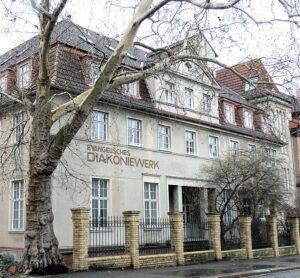
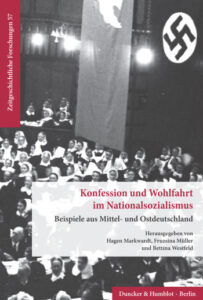 The focus on the regions of Central and Eastern Germany is a response to the current dearth of research on that region. Because denominational institutions were relatively autonomous at that time, such a regional delimitation makes perfect sense. Due to the denominational character of the region, then, most of the contributions deal with institutions and actors from the Protestant (evangelisch) spectrum, which is understandable. This will allow comparisons to be drawn between the various actors and institutions in different regions of Germany at a later point in time. It is regrettable that the editors did not succeed in soliciting contributions on the Thuringian region. They have focused on Silesia, however, which has also been rarely examined by research so far. A positive point to be emphasized here is the approach of the editors, acknowledging that the “relationship between the Christian-denominational institutions and the Nazi rule [are] not to [be understood] from the outset as dichotomous” (p. 11). Even if this approach should be a matter of course from this reviewer’s point of view, recent works show again and again that an ideological opposition between Christians and National Socialists is frequently assumed from the outset. Therefore, as self-evident as it may be, the editors’ basic attitude as it is formulated and implemented in the book is to be appreciated.
The focus on the regions of Central and Eastern Germany is a response to the current dearth of research on that region. Because denominational institutions were relatively autonomous at that time, such a regional delimitation makes perfect sense. Due to the denominational character of the region, then, most of the contributions deal with institutions and actors from the Protestant (evangelisch) spectrum, which is understandable. This will allow comparisons to be drawn between the various actors and institutions in different regions of Germany at a later point in time. It is regrettable that the editors did not succeed in soliciting contributions on the Thuringian region. They have focused on Silesia, however, which has also been rarely examined by research so far. A positive point to be emphasized here is the approach of the editors, acknowledging that the “relationship between the Christian-denominational institutions and the Nazi rule [are] not to [be understood] from the outset as dichotomous” (p. 11). Even if this approach should be a matter of course from this reviewer’s point of view, recent works show again and again that an ideological opposition between Christians and National Socialists is frequently assumed from the outset. Therefore, as self-evident as it may be, the editors’ basic attitude as it is formulated and implemented in the book is to be appreciated. Loth argues that much relevant scholarship has rested on Rainer Lepsius’ theory of a closed Catholic milieu, largely dominated by ultramontane clergy.
Loth argues that much relevant scholarship has rested on Rainer Lepsius’ theory of a closed Catholic milieu, largely dominated by ultramontane clergy.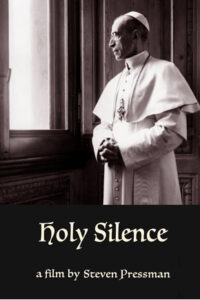 The film features several academics familiar to CCHQ readers, including members of the editorial team Kevin Spicer and Suzanne Brown-Fleming. Interviews with Robert Ventresca, Susan Zuccotti, Michael Phayer, Maria Mazzenga, and many others are interspersed with historic footage, and occasional re-enactment to explore the actions of popes Pius XI and XII and some of the innerworkings of the Vatican. Pressman offers a range of voices, including a few outliers like Norbert Hofmann, Secretary of the Holy See’s Commission for Jewish Relations, who views Pius XII in a sympathetic light. We also hear contrasting viewpoints from Sister Maria Pascalizi of the Roman Convent of Santa Maria dei Sette Dolori and Micaela Pavoncello, a local Jew, about the Vatican’s role in sanctioning or encouraging the hiding of Jews in churches.
The film features several academics familiar to CCHQ readers, including members of the editorial team Kevin Spicer and Suzanne Brown-Fleming. Interviews with Robert Ventresca, Susan Zuccotti, Michael Phayer, Maria Mazzenga, and many others are interspersed with historic footage, and occasional re-enactment to explore the actions of popes Pius XI and XII and some of the innerworkings of the Vatican. Pressman offers a range of voices, including a few outliers like Norbert Hofmann, Secretary of the Holy See’s Commission for Jewish Relations, who views Pius XII in a sympathetic light. We also hear contrasting viewpoints from Sister Maria Pascalizi of the Roman Convent of Santa Maria dei Sette Dolori and Micaela Pavoncello, a local Jew, about the Vatican’s role in sanctioning or encouraging the hiding of Jews in churches.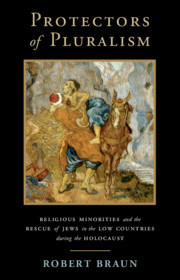 Because this is a work of social science, it employs a methodology very different from how historians approach research and thus warrants some explanation. Braun begins with a hypothesis that religious minorities are more likely to assist or rescue persecuted groups from mass violence or genocide. In this framing, religious minorities could hold minority status on a national level because of their small size (e.g., Quakers) or they could be a minority in a given region—Catholics in a majority Protestant region and vice versa. This minority theory is based on the idea that religious minorities recognize a shared vulnerability with other minorities, which triggers empathy. Braun posits that all religious communities seek security and self-preservation. When they cannot achieve this through religious dominance, then pluralism is the next safest option to ensure survival. So, a commitment to pluralism accounts for the willingness factor but minority status also enables capacity. Minority communities are able to engage in clandestine collective action while reducing exposure because of their members’ commitment and their relative isolation (more on isolation below). (40)
Because this is a work of social science, it employs a methodology very different from how historians approach research and thus warrants some explanation. Braun begins with a hypothesis that religious minorities are more likely to assist or rescue persecuted groups from mass violence or genocide. In this framing, religious minorities could hold minority status on a national level because of their small size (e.g., Quakers) or they could be a minority in a given region—Catholics in a majority Protestant region and vice versa. This minority theory is based on the idea that religious minorities recognize a shared vulnerability with other minorities, which triggers empathy. Braun posits that all religious communities seek security and self-preservation. When they cannot achieve this through religious dominance, then pluralism is the next safest option to ensure survival. So, a commitment to pluralism accounts for the willingness factor but minority status also enables capacity. Minority communities are able to engage in clandestine collective action while reducing exposure because of their members’ commitment and their relative isolation (more on isolation below). (40)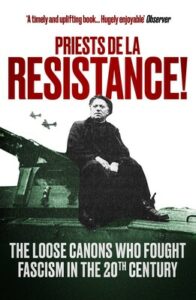 The book is divided into five sections, beginning in occupied France, with stories of “resistance par excellence” focusing on the lives of Canon Felix Kir (of blanc de cassis aka “Kir” fame) and Abbe Pierre (born Henri Marie Joseph Groues). Both of these individuals engaged in acts of sabotage, rescue work (especially of persecuted Jews), and generally served as thorns in the sides of the Nazis and their French collaborators.
The book is divided into five sections, beginning in occupied France, with stories of “resistance par excellence” focusing on the lives of Canon Felix Kir (of blanc de cassis aka “Kir” fame) and Abbe Pierre (born Henri Marie Joseph Groues). Both of these individuals engaged in acts of sabotage, rescue work (especially of persecuted Jews), and generally served as thorns in the sides of the Nazis and their French collaborators.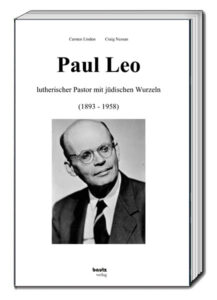 Based on extensive archival source material, Linden describes Paul Leo’s early professional career. When the National Socialists came to power, Leo faced increasing difficulties due to his Jewish ancestors. Why Linden then adopts the racial biological interpretations of the National Socialists in this regard and describes Paul Leo as the “Jewish pastor of the regional church” (p. 19) is disturbing, however. Unfortunately, Linden also makes significant mistakes in terms of content: The Confessing Church did not form due to alleged state and National Socialist (where should a dividing line be drawn here?) interventions in church affairs (p. 18). This apologetic church historiography of the 1950s has been refuted many times in recent years, which should be taken into account when dealing with such a topic.
Based on extensive archival source material, Linden describes Paul Leo’s early professional career. When the National Socialists came to power, Leo faced increasing difficulties due to his Jewish ancestors. Why Linden then adopts the racial biological interpretations of the National Socialists in this regard and describes Paul Leo as the “Jewish pastor of the regional church” (p. 19) is disturbing, however. Unfortunately, Linden also makes significant mistakes in terms of content: The Confessing Church did not form due to alleged state and National Socialist (where should a dividing line be drawn here?) interventions in church affairs (p. 18). This apologetic church historiography of the 1950s has been refuted many times in recent years, which should be taken into account when dealing with such a topic.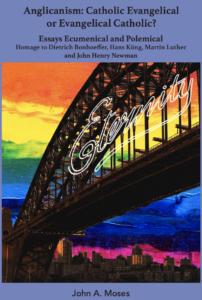 In his foreword to the book, Mark Lindsay welcomes Moses warmly into the realm of contemporary theological angst, affirming the proper place of a historian in all such things. This may seem all too obvious, but then the authority of the historical craft, and of historical knowledge altogether, has for some years now become increasingly obscure to those who oversee the life and work of most of our Protestant churches. When a moment of vital significance turns up historians are seldom to be found in the counsels of authority. If anything, they are likely to be deliberately excluded from them, though they might now and then be recruited to write introductory paragraphs. Evidently, we are all expected to return to a vigorous state of primitive Christianity as though nothing of significance has occurred across the intervening centuries. But there may be other reasons to maintain this state of ignorance. The historian of the modern church is not quite a tame creature. The churches prefer a show of loyalty, while those in charge of them care not at all to be criticised. Historians tend to do this rather freely, particularly when provoked. The historian of the Reformation may unhelpfully point out doctrinal contradictions or emphasize acts of violence. The historian of secularization will certainly prove to be bad for morale. As for the historians of the Third Reich, it is much safer to leave them in their university departments than to invite them to observe patterns and parallels. And why should there be any, after all?
In his foreword to the book, Mark Lindsay welcomes Moses warmly into the realm of contemporary theological angst, affirming the proper place of a historian in all such things. This may seem all too obvious, but then the authority of the historical craft, and of historical knowledge altogether, has for some years now become increasingly obscure to those who oversee the life and work of most of our Protestant churches. When a moment of vital significance turns up historians are seldom to be found in the counsels of authority. If anything, they are likely to be deliberately excluded from them, though they might now and then be recruited to write introductory paragraphs. Evidently, we are all expected to return to a vigorous state of primitive Christianity as though nothing of significance has occurred across the intervening centuries. But there may be other reasons to maintain this state of ignorance. The historian of the modern church is not quite a tame creature. The churches prefer a show of loyalty, while those in charge of them care not at all to be criticised. Historians tend to do this rather freely, particularly when provoked. The historian of the Reformation may unhelpfully point out doctrinal contradictions or emphasize acts of violence. The historian of secularization will certainly prove to be bad for morale. As for the historians of the Third Reich, it is much safer to leave them in their university departments than to invite them to observe patterns and parallels. And why should there be any, after all?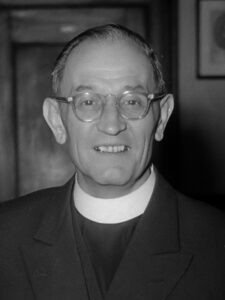
 Many studies on the existence of churches under National Socialism point to the Warthegau as a blueprint of the Nazi state’s plans of actions for the future of all churches in Germany. Generally, however, historians have drawn such conclusions prematurely, basing them on select archival documents without examining the broader context of Nazi policies for the Warthegau and for Poland as a whole. By setting right these ill-considered assumptions, Huener situates his analysis of the church’s plight in the Warthegau clearly in the Nazi state’s Kirchenpolitik and Volkstumskampf or ethno-racial struggle. Dominating this regional policy was Arthur Greiser, a native of the region and the Warthegau’s long-serving (1939-1945) Gauleiter (district leader) and Reichsstatthalter (Reich governor), and his deputy, August Jäger, whom historian Klaus Scholder had previously identified as instrumental in intensifying state involvement in Protestant Church affairs in the initial years of Nazi rule. Huener mentions but does not explore this connection. Greiser and Jäger did not act alone. From Munich, Martin Bormann, chief of staff in the Office of the Deputy Führer and, after May 1941, head of the party chancellery, and from Berlin, Heinrich Himmler, SS Leader and Reich Commissioner for the Consolidation of German Nationhood, influenced Warthegau church policy while also allowing Greiser freedom to craft and implement it locally. The result revealed competing concerns between the ethno-racial struggle against Poles and an existing distrust of Catholicism. What historians have traditionally interpreted as attacks on Christianity by limiting or prohibiting Masses, Huener explains, were primarily security measures implemented by the occupiers to “prevent Poles from congregating and fomenting dissent or resistance” while they continued their policy of “undermin[ing] Poles’ sense of national identity and community” (6). Amid such motivations, strong anti-church sentiments also existed.
Many studies on the existence of churches under National Socialism point to the Warthegau as a blueprint of the Nazi state’s plans of actions for the future of all churches in Germany. Generally, however, historians have drawn such conclusions prematurely, basing them on select archival documents without examining the broader context of Nazi policies for the Warthegau and for Poland as a whole. By setting right these ill-considered assumptions, Huener situates his analysis of the church’s plight in the Warthegau clearly in the Nazi state’s Kirchenpolitik and Volkstumskampf or ethno-racial struggle. Dominating this regional policy was Arthur Greiser, a native of the region and the Warthegau’s long-serving (1939-1945) Gauleiter (district leader) and Reichsstatthalter (Reich governor), and his deputy, August Jäger, whom historian Klaus Scholder had previously identified as instrumental in intensifying state involvement in Protestant Church affairs in the initial years of Nazi rule. Huener mentions but does not explore this connection. Greiser and Jäger did not act alone. From Munich, Martin Bormann, chief of staff in the Office of the Deputy Führer and, after May 1941, head of the party chancellery, and from Berlin, Heinrich Himmler, SS Leader and Reich Commissioner for the Consolidation of German Nationhood, influenced Warthegau church policy while also allowing Greiser freedom to craft and implement it locally. The result revealed competing concerns between the ethno-racial struggle against Poles and an existing distrust of Catholicism. What historians have traditionally interpreted as attacks on Christianity by limiting or prohibiting Masses, Huener explains, were primarily security measures implemented by the occupiers to “prevent Poles from congregating and fomenting dissent or resistance” while they continued their policy of “undermin[ing] Poles’ sense of national identity and community” (6). Amid such motivations, strong anti-church sentiments also existed.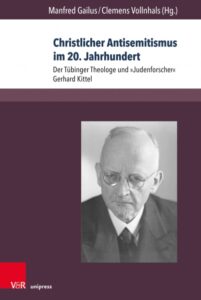 In a wide-ranging introduction, the editors skillfully contextualize the issues surrounding Protestant anti-Judaism and antisemitism during the Third Reich. Gailus and Vollnhals use the national reactions to the commemoration of the 500th anniversary of the German Protestant Reformation as a jumping off point. These 2017 commemorations included – for the first time in a Luther jubilee year – critical analysis of the reformer’s “Judenschriften,” of which the deeply anti-Judaic and antisemitic Von den Juden und ihren Lügen (On the Jews and Their Lies) stands out. Very soon after these commemorations ended, a group of historians, church historians, theologians, and religion scholars met in Dresden to assess Kittel’s biography, work, and legacy (7), which occasioned the present volume. Though Luther and Kittel lived and worked in vastly different historical contexts, their oeuvres stir similar debates about animus toward Jews and Judaism in Protestant theology and their real-world effects (8). Despite some overlap and repetition, the essays that follow address these issues in a comprehensive and satisfying fashion.
In a wide-ranging introduction, the editors skillfully contextualize the issues surrounding Protestant anti-Judaism and antisemitism during the Third Reich. Gailus and Vollnhals use the national reactions to the commemoration of the 500th anniversary of the German Protestant Reformation as a jumping off point. These 2017 commemorations included – for the first time in a Luther jubilee year – critical analysis of the reformer’s “Judenschriften,” of which the deeply anti-Judaic and antisemitic Von den Juden und ihren Lügen (On the Jews and Their Lies) stands out. Very soon after these commemorations ended, a group of historians, church historians, theologians, and religion scholars met in Dresden to assess Kittel’s biography, work, and legacy (7), which occasioned the present volume. Though Luther and Kittel lived and worked in vastly different historical contexts, their oeuvres stir similar debates about animus toward Jews and Judaism in Protestant theology and their real-world effects (8). Despite some overlap and repetition, the essays that follow address these issues in a comprehensive and satisfying fashion.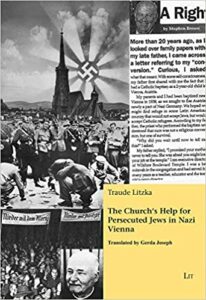 Despite the challenges of locating survivors and documents which would testify to the actions of the brave Catholic men and women engaged in rescue work, Litzka has assembled quite a roster of both individuals as well as orders of religious who decided that, despite the threat of arrest, interrogation, and imprisonment (or worse), their consciences would not allow them to remain inactive in the face of overwhelming discrimination and hardships. One such man who figures prominently throughout the book is the Jesuit priest, Ludger Born (born in Duisburg in 1897). Born was appointed as head of the “Aid Office for Non-Aryan Catholics” by Cardinal Theodor Innitzer in 1940 and for the next five years, Father Born worked assiduously to aid all those who needed help. He inherited his position from another priest, Father Georg Bichlmair, who had established the office and had staffed it primarily with dedicated women. Some of these women’s stories were later documented after the war by Father Born, providing some insight into both their identity and motivations. Out of the twenty-three employees, Father Born’s documentation focused on only five of the female workers. He attributed their dedication to their profound religiosity.
Despite the challenges of locating survivors and documents which would testify to the actions of the brave Catholic men and women engaged in rescue work, Litzka has assembled quite a roster of both individuals as well as orders of religious who decided that, despite the threat of arrest, interrogation, and imprisonment (or worse), their consciences would not allow them to remain inactive in the face of overwhelming discrimination and hardships. One such man who figures prominently throughout the book is the Jesuit priest, Ludger Born (born in Duisburg in 1897). Born was appointed as head of the “Aid Office for Non-Aryan Catholics” by Cardinal Theodor Innitzer in 1940 and for the next five years, Father Born worked assiduously to aid all those who needed help. He inherited his position from another priest, Father Georg Bichlmair, who had established the office and had staffed it primarily with dedicated women. Some of these women’s stories were later documented after the war by Father Born, providing some insight into both their identity and motivations. Out of the twenty-three employees, Father Born’s documentation focused on only five of the female workers. He attributed their dedication to their profound religiosity.